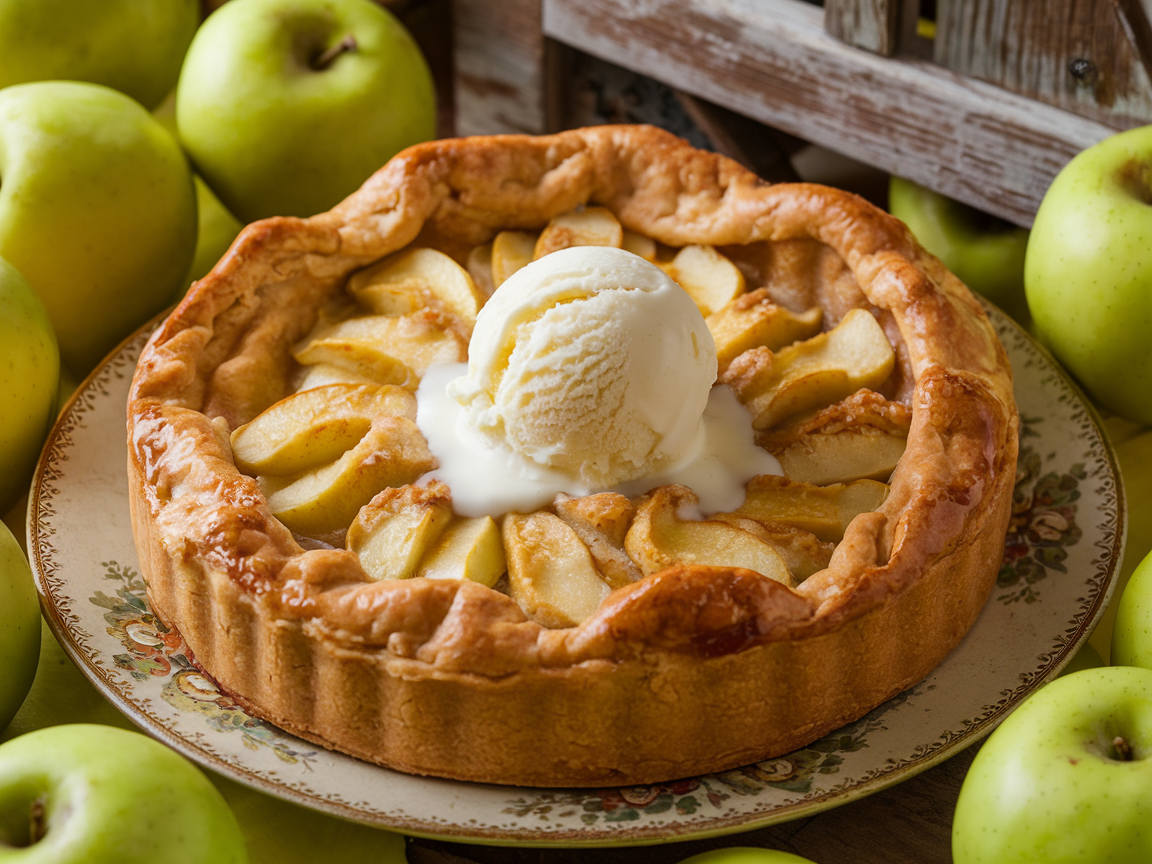Introduction to French Rustic Apple Pie
Ah, the French rustic apple pie—a dessert that combines simplicity and elegance in one delicious creation. If you’ve ever seen one, you’d know it doesn’t look as “polished” as the pies you’ll find in bakeries. Instead, it boasts a free-form crust and uneven edges that give it a homespun, artistic charm. But don’t let the term “rustic” fool you; this pie delivers flavors that can rival even the most gourmet desserts.
Unlike traditional apple pies, a French rustic apple pie—often called a galette—embraces imperfection. It’s perfect for anyone who loves baking but doesn’t want to fuss over latticed crusts or intricate designs. Plus, it’s less intimidating for beginners because you simply fold the edges of the pastry over the apples and bake—voila, perfection!
“The beauty of a rustic apple pie lies in its imperfections. Every wrinkle in the crust tells a story of love, care, and homemade goodness.”
🍎 But what makes a French rustic apple pie truly unique? Why is it adored across kitchens worldwide? Let’s dive into its history, ingredients, and the magic of this classic French dessert.
Origins of the French Rustic Apple Pie
When we hear French rustic apple pie, it immediately conjures up images of the French countryside—cozy kitchens, wooden tables, and fresh apples from the orchard. The recipe for this pie dates back to rural France, where bakers made use of simple, readily available ingredients.
The French galette, as it’s traditionally known, was more than just a dessert—it was a way of life. Farmers’ wives would prepare these pies using fruits that were in season, saving nothing and creating something delicious out of humble beginnings. The freeform crust wasn’t about aesthetics but rather practicality; it was quick and easy to make.
Rustic apple pies are a part of the peasant cuisine tradition in France, which celebrates resourcefulness and natural flavors. Even today, many chefs in France and around the world still prefer this classic dessert because of its authentic, unfussy style.
Why is it Called “Rustic”?
The term “rustic” describes the pie’s appearance and preparation method. Unlike classic American pies with their flawless presentation, rustic apple pies celebrate simplicity. There’s no need for a pie dish; you simply roll out the dough, place the filling in the center, and fold the edges around it.
The uneven folds and edges give the pie its “rough” or rustic look. It’s like the difference between wearing a tailored suit and a cozy sweater—both are great, but one is undeniably more relaxed and down-to-earth.
So, don’t worry if your pie looks messy—it’s supposed to!
“A rustic pie isn’t about perfection—it’s about flavor, simplicity, and celebrating real, homemade cooking.”
Key Ingredients for a French Rustic Apple Pie
To create a pie that’s both simple and delicious, you’ll need to pay close attention to your ingredients. Here’s what makes up the heart of a rustic apple pie:
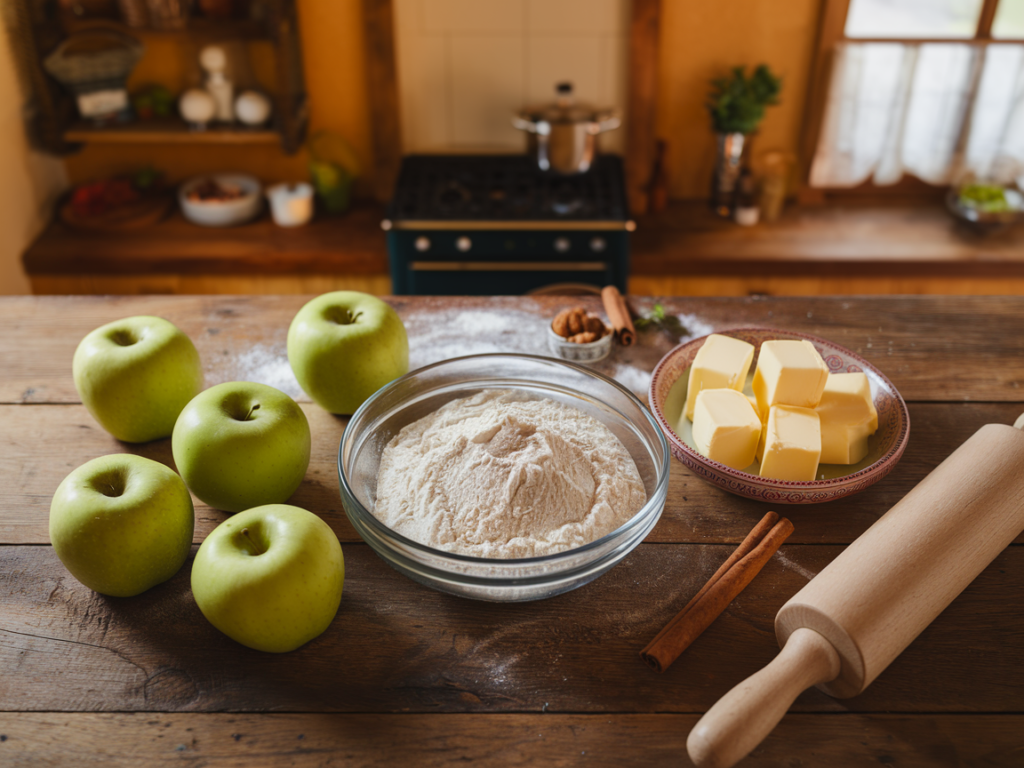
Apples: Choosing the Right Variety
The star of the show is, of course, the apples. But not all apples are created equal when it comes to baking.
- Best Apples for Baking:
- Granny Smith (tart and firm)
- Honeycrisp (sweet with a crisp bite)
- Braeburn (balanced sweetness and tartness)
- Jonagold (sweet-tart flavor)
These varieties hold their shape well and provide the perfect balance of sweetness and acidity. Avoid overly soft apples like Red Delicious, as they tend to turn mushy.
The Role of Pastry: Homemade vs. Store-Bought
The crust is what gives this pie its rustic charm. While store-bought pastry works in a pinch, homemade dough will take your pie to the next level. A classic pâte brisée—a French shortcrust pastry—is ideal because it’s buttery, flaky, and easy to handle.
Ingredients for Pâte Brisée:
- 1 ½ cups all-purpose flour
- 1 stick (½ cup) unsalted butter, chilled and cubed
- ¼ teaspoon salt
- 4-5 tablespoons ice water
Don’t stress over imperfections when rolling the dough—remember, rustic is the goal!
Spices and Sweeteners That Enhance Flavor
A sprinkle of spice can transform your pie into a cozy masterpiece. Here are the essentials:
- Cinnamon: The classic spice that pairs perfectly with apples.
- Nutmeg: Adds warmth and depth.
- Brown Sugar: Enhances sweetness while adding a caramel-like flavor.
- Honey or Maple Syrup: For natural sweetness with a hint of earthiness.
Optional additions like a dash of vanilla extract or lemon zest can add another layer of flavor to your pie.
Step-by-Step Guide to Making a Rustic Apple Pie
Now that you know the basics, let’s get into the fun part—making the pie! Here’s an easy-to-follow guide:
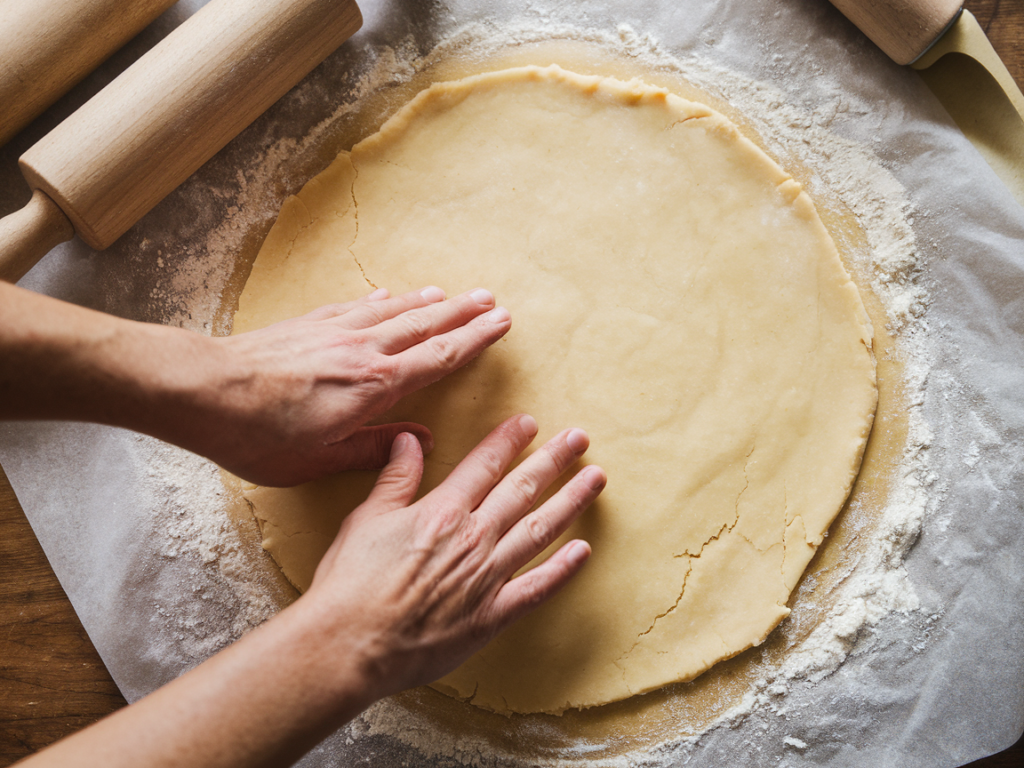
Preparing the Dough
- In a large bowl, combine flour and salt.
- Add chilled butter and mix with your hands (or a pastry cutter) until the mixture resembles coarse crumbs.
- Gradually add ice water, one tablespoon at a time, mixing until the dough comes together.
- Form the dough into a ball, wrap in plastic wrap, and chill for at least 30 minutes.
Crafting the Perfect Apple Filling
- Peel and slice 4-5 apples into thin wedges.
- Toss the apples with brown sugar, cinnamon, nutmeg, and a squeeze of lemon juice.
- Let the apples sit for 10-15 minutes to release their juices.
Assembling and Baking the Pie
- Roll out the dough into a rough circle (about 12 inches wide).
- Place the apple mixture in the center, leaving a 2-inch border.
- Gently fold the edges of the dough over the apples, overlapping as needed.
- Brush the crust with an egg wash (beaten egg + a splash of milk) for a golden finish.
- Sprinkle the pie with a little sugar for added crunch.
- Bake at 375°F (190°C) for 35-40 minutes or until the crust is golden and the apples are tender.
Let the pie cool slightly before serving. Trust me, the smell alone will have everyone gathering in the kitchen!
Common Problems When Baking Rustic Apple Pie
Even though a rustic apple pie is easier to prepare than traditional pies, there are still a few pitfalls you might encounter. Don’t worry—I’ve got you covered with solutions to the most common problems.
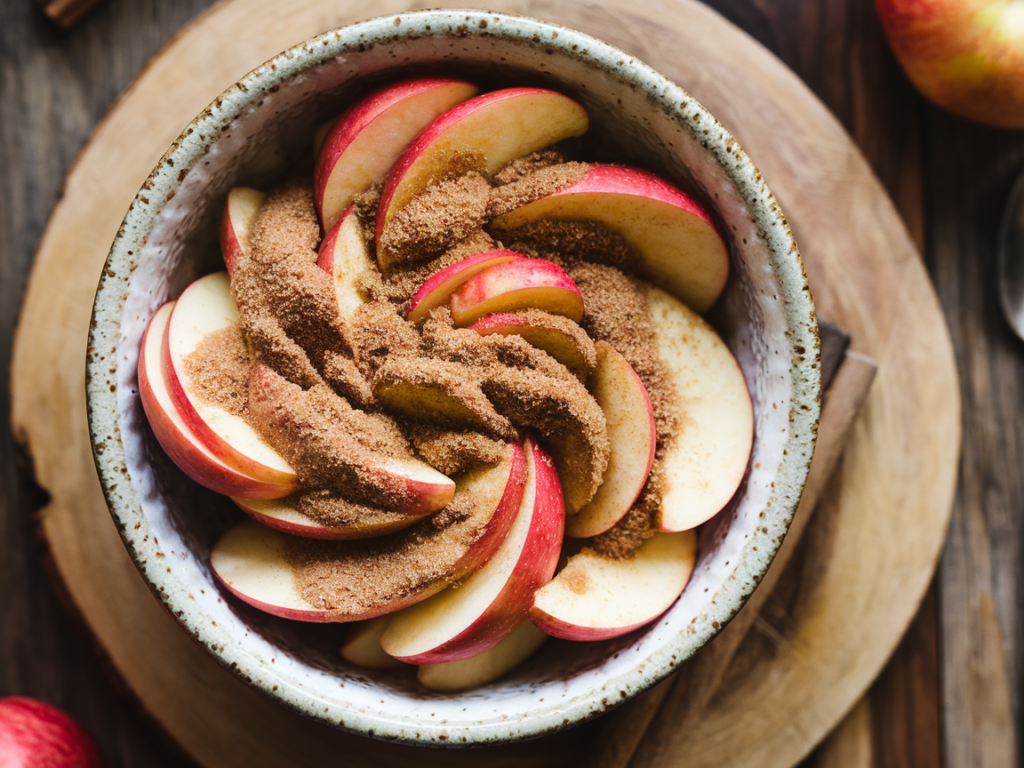
The Dough is Too Dry or Crumbly
A dry or crumbly dough can make it difficult to roll out and fold without cracking. This happens when there isn’t enough moisture in the dough or the butter isn’t incorporated properly.
Solution:
- Add water gradually—one tablespoon at a time—until the dough just comes together.
- Always use ice-cold water and chilled butter; it helps bind the dough without making it sticky.
- Don’t overwork the dough. A light hand keeps it tender and flaky.
Pro Tip: If your dough feels stubborn, let it rest for 10 minutes before rolling it out. This relaxes the gluten, making it more pliable.
The Filling is Too Watery
Nothing is worse than a pie that spills liquid everywhere when you slice into it. Watery fillings usually result from using overly juicy apples or skipping a thickening agent.
Solution:
- Use apples that are firm and not overly ripe. Varieties like Granny Smith and Honeycrisp work best.
- Add a thickener like a tablespoon of cornstarch, flour, or tapioca to the apple mixture to absorb excess juice.
- Let the apples sit for 10-15 minutes after tossing them with sugar and spices. Then, drain any extra liquid before placing them in the dough.
How to Prevent a Soggy Crust
A soggy bottom crust can ruin an otherwise perfect pie. It happens when juices from the apples seep into the pastry during baking.
Solution:
- Sprinkle a light layer of breadcrumbs, semolina, or flour on the dough before adding the filling. This absorbs excess liquid without altering the flavor.
- Bake the pie on a preheated baking sheet. The direct heat helps crisp up the bottom crust.
- Brush a thin layer of beaten egg white onto the rolled-out dough. It acts as a barrier to prevent the filling from soaking in.
“Crispy crust, juicy apples—mastering this balance makes your rustic apple pie a true showstopper.”
Tips and Tricks for the Perfect Rustic Apple Pie
Baking a French rustic apple pie may seem straightforward, but a few tips can elevate your pie to professional-level perfection.
Achieving the Right Texture and Flavor
- Slice the apples thinly and uniformly: This ensures they cook evenly and develop a soft, tender texture.
- Use a mix of apple varieties: Combining tart and sweet apples creates a balanced flavor profile.
- Add a hint of lemon zest: It brightens the flavor and complements the spices beautifully.
Best Tools for Baking
Having the right tools makes the process much smoother:
- Rolling Pin: For evenly rolling out your dough.
- Parchment Paper: Makes transferring and cleaning up easy.
- Baking Stone or Steel: Ensures even heat distribution for a perfectly crisp crust.
Variations of the French Rustic Apple Pie
While the classic version of this pie is undeniably delicious, you can get creative and add your own spin. Here are a few variations to try:
Adding Nuts or Caramel
- Sprinkle chopped walnuts or pecans over the apple filling for a satisfying crunch.
- Drizzle homemade caramel sauce on the apples before baking for an extra decadent treat.
Using Seasonal Fruits
- Combine apples with pears, plums, or cranberries for a seasonal twist.
- In summer, swap apples for peaches or berries to enjoy a refreshing galette.
🍏 “The beauty of a rustic pie is its versatility—feel free to experiment with whatever fruits are in season!”
Pairing Rustic Apple Pie with Beverages
No dessert is complete without the perfect drink to accompany it. Here are some delightful pairing suggestions:
Tea and Coffee Pairings
- Earl Grey Tea: Its citrusy notes complement the warm spices in the pie.
- Black Coffee: A strong, bold brew balances the sweetness of the apples.
Dessert Wines and Ciders
- Hard Apple Cider: A natural companion to apple desserts, enhancing the pie’s flavors.
- Late-Harvest Riesling: This sweet wine pairs beautifully with the buttery crust and spiced apples.
“Think of your beverage as the final touch—a sip of perfection that brings out the pie’s full potential.”
French Rustic Apple Pie: A Cultural Delight
At its core, the French rustic apple pie reflects the heart of French culinary traditions—simplicity, flavor, and love. It’s a dessert that brings people together, whether it’s served at a family gathering or enjoyed alone with a cozy blanket and a book.
In France, food isn’t just about eating; it’s about sharing moments and creating memories. A slice of rustic apple pie embodies this spirit, turning something as humble as apples and dough into a masterpiece.
🍏 “Food is memories, and every bite of a French rustic apple pie tells a story of tradition, family, and warmth.”
Health Benefits of Ingredients in Rustic Apple Pie
While a French rustic apple pie is undoubtedly a treat, it also packs some surprising health benefits, thanks to its wholesome ingredients. Let’s take a closer look at why this dessert can be guilt-free in moderation:
Apples: The Heart of the Pie
Apples are loaded with nutrients that make them one of the healthiest fruits around:
- Rich in fiber: Apples aid digestion and keep you feeling full.
- Packed with antioxidants: They help fight inflammation and reduce the risk of chronic diseases.
- Supports heart health: The flavonoids in apples are great for maintaining healthy cholesterol levels.
“An apple a day keeps the doctor away” isn’t just a saying—it’s science! Plus, when paired with warm spices like cinnamon, apples deliver not only health benefits but also unbeatable flavor.
Cinnamon and Nutmeg: Super Spices
Spices aren’t just for taste; they also provide impressive health perks:
- Cinnamon: Known for its anti-inflammatory and blood sugar-regulating properties.
- Nutmeg: Boosts digestion, supports sleep, and has natural antibacterial benefits.
These two simple spices transform your rustic pie into a warm, cozy remedy for both the body and soul.
Homemade Dough: Better Control Over Ingredients
Making your pastry at home gives you control over what goes into it. By using natural, high-quality ingredients like:
- Butter: A source of healthy fats and essential vitamins (A, E, D).
- Whole wheat flour (optional): Adds more fiber and nutrients compared to white flour.
By avoiding artificial preservatives and excessive sugars, your rustic pie stays a healthier option than store-bought desserts.
Conclusion: Why You Should Try French Rustic Apple Pie
If you haven’t yet fallen in love with the idea of a French rustic apple pie, let me remind you of its charm:
- It’s simple to make yet incredibly elegant.
- It uses fresh, wholesome ingredients that bring rich flavors to the table.
- It’s the perfect dessert for any occasion—casual dinners, family gatherings, or even a cozy night alone.
Whether you’re a seasoned baker or someone who’s just starting out, this pie is forgiving and delightful to create. You don’t need perfection; you need passion. And with a little love and a few apples, you’ll end up with a pie that looks rustic but tastes like pure magic.
🍏 “There’s something timeless about a French rustic apple pie—it’s comfort food, elevated.”
Frequently Asked Questions (FAQs)
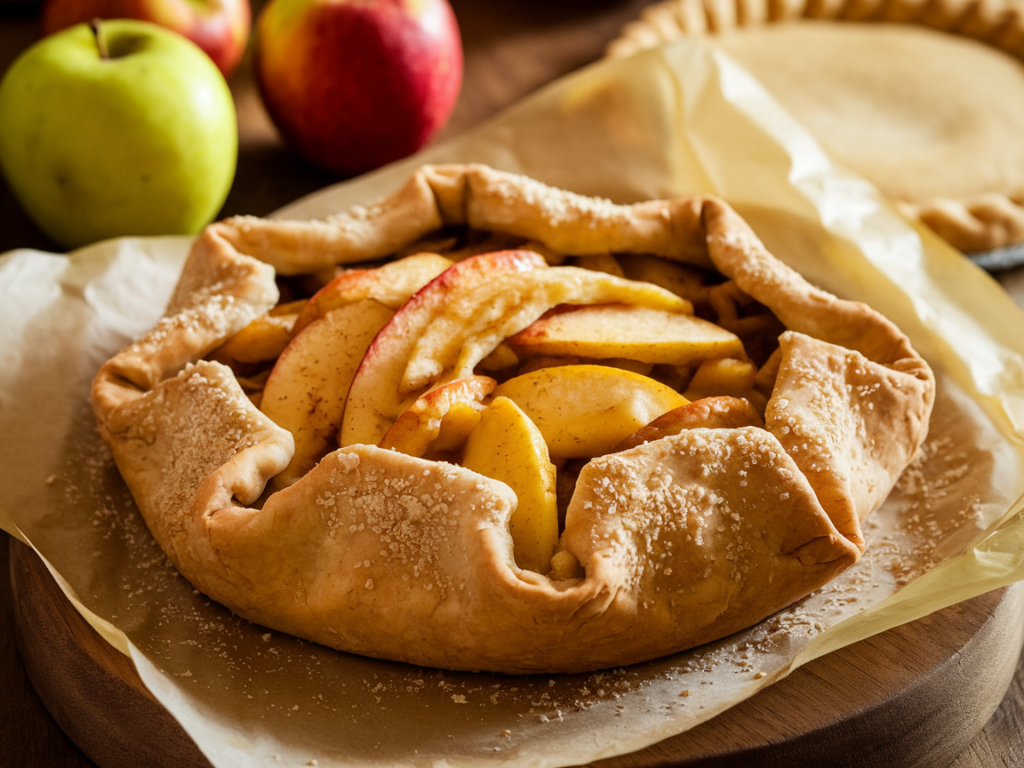
Here are answers to some common questions about making and enjoying a French rustic apple pie:
Can I make the dough ahead of time?
Yes! The dough can be prepared a day in advance. Just wrap it tightly in plastic wrap and refrigerate. Let it sit at room temperature for 10 minutes before rolling it out.
How long does a rustic apple pie last?
A rustic apple pie can be stored at room temperature for up to 2 days. For longer storage, keep it in the refrigerator for 4-5 days. Reheat in the oven for a fresh-baked taste.
Can I freeze a rustic apple pie?
Absolutely! You can freeze the unbaked pie or freeze it after baking. To reheat, bake the frozen pie at 350°F (175°C) until warmed through.
What’s the best way to serve rustic apple pie?
Serve it warm with a scoop of vanilla ice cream or a dollop of whipped cream. If you’re feeling indulgent, drizzle some caramel sauce on top.
Can I add other fruits to the filling?
Yes! You can mix apples with pears, plums, or berries for a seasonal variation. Just adjust the sugar to match the sweetness of the additional fruits.
Block Quote to End:
🍎 “Baking a rustic apple pie is more than just making dessert; it’s crafting memories, one slice at a time.”
Here are suggested links for rich anchor text to enhance the article’s internal SEO:
- “Why Does Apple Go with Cinnamon?”
Enhance the section about cinnamon pairing with apples by linking to:
Why does apple go with cinnamon? - “Should You Pre-Cook Apple Pie Filling?”
Add value to the tips section by discussing filling preparation:
Should you pre-cook apple pie filling? - “Cinnamon Rolls with Apple Pie Filling”
Highlight how versatile apple pie filling can be:
Cinnamon Rolls with Apple Pie Filling - “French Apple Pie Recipe”
Guide readers to a related recipe for comparison:
French Apple Pie Recipe - “Gluten-Free Apple Pie Recipe”
Offer a dietary alternative for gluten-sensitive readers:
Gluten-Free Apple Pie Recipe
Conclusion
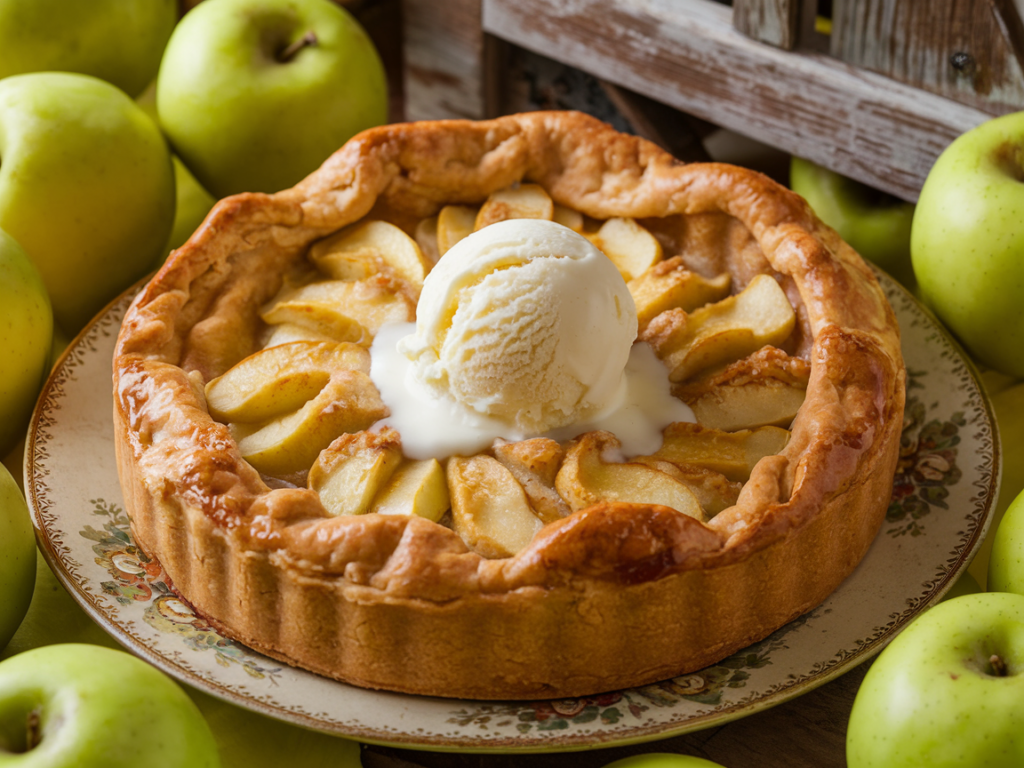
The French Rustic Apple Pie celebrates simplicity, flavor, and charm. For bakers seeking a stress-free yet elegant dessert, this recipe is a must-try. Be sure to explore related articles like Why does apple go with cinnamon? and others linked above to enhance your apple dessert knowledge!

